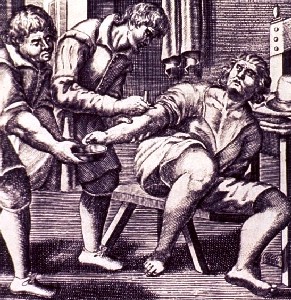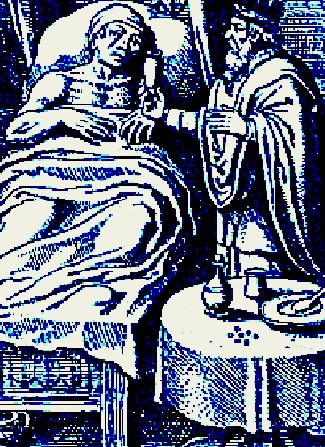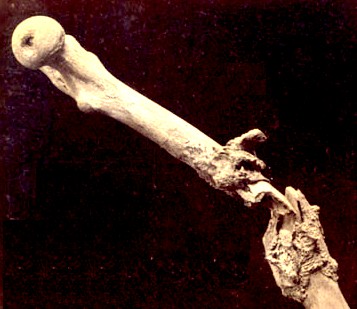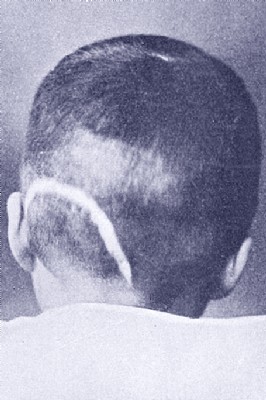
Head Surgery Page Menu: 1 2 3 4 5 6 7 8 9 10 11 12 13 14 <<First
Head Surgery During the Golden Age of Piracy, Page 14
Head Wound Post-Op: Humoral Treatments
Humor-based treatments included several procedures. They were designed to prevent 'corrupted' humors [typically thought to be fluid] from forming at the wound site or at least to divert the uncorrupted humors away from the wound site so they could not be corrupted. Medical professionals generally recognized four bodily humors, the primary one of interest to treating wounds being blood as we saw in the pre-operational procedures for surgery on the head. However, this was not the end of their role in wounds. Period surgeons suggest that humors caused infection and even gangrene when they were trapped at a wound site without identifying which particular humor was responsible. As a result, various treatments were employed to keep the corrupted ones at bay.

Bloodletting, from Nuova et Utlilssima Prattica di Tutto
Quello Ch'al Diligente Barbier s'Appartiene,
by Cintio Damato, p. 51 (1671)
Just as it was used before operations on the head, bloodletting was performed afterwards, in some cases not long after. In one of his case studies, French surgical instructor Pierre Dionis says the surgeon should "return again to bleed him [the patient] two or three Hours after the Operation"1.
Other surgeons waited a bit longer. Richard Wiseman reports that on the second day after trepanning a patient, "I let him blood 10 Ounces"2. Wiseman doesn't specify the location of the bloodletting, although it was likely either taken from the arm (one of the more common locations for intentional bleeding) or possibly the neck.
Sea surgeon John Woodall points to the arm as the appropriate location, advising that "it is good to open the Cephalicke vaine [cephalic - a superficial vein in the arm] if the braine have beene long uncovered, or yeelde a spumous [frothy] white and thicke excrement, which seemes to bee a portion of the substance of the braine"3.
Other surgeons recommended regular bleeding. Sea surgeon John Moyle explains that the surgeon should "let the man have a Vein opened, (for if you neglect this there is no living) therefore let it be done often"4. Moyle doesn't specify how often this should be done, but it was fairly common to bleed patients regularly during recovery from a serious wound. In one of his case studies, Moyle does give some insight into the reason for bleeding after such an operation in one of his case studies: "to prevent a Fever (because he seem’d something restless, and was Plethoric [of a humoral temperament that was 'congested' with blood] withal) I made venae Section [let blood] again the next Day."5
Another popular method for purging unwanted humors was to eliminate them via enemas. Moyle said to keep the patient's "body open with Enameticks [medicinal enemas]"6. In one of his case studies, he notes that his patient had "Enemas as occasion required"7. Richard Wiseman likewise "advised the repeating of Clysters &c. [enemas] as occasion should offer"8.

Bringing the Enema Syringe, From Ars sanandi cum
expectalione, by Georg Ernst Stahl (1730)
Woodall is perhaps the most effusive in his recommending enemas. He directs the surgeon's mate to "inquire of the Patient if hee have the benefit of nature [eased his bowels], if not, procure him one, not many stooles, and onely see he have naturall stooles once a day, or in two daies, not by potion nor pills, but rather by glister [clyster - enema] or suppositorie."9 Woodall elsewhere recommends "the use of glisters [clysters - enemas] likewise upon good reasons is also to be approved, and it is good ... likewise to purge the body"10.
A rather interesting recommendation by Moyle is to cause the patient to perspire. He advises the surgeon to "be sure you lay your Patient so as to sweat (a breathing sweat) for that is very wholsome, and necessary in this case."11 Although this suggests the necessity for keeping the patient warm which has been mentioned several times already, he is actually referring to a humor-based treatment involving heat and medicines that caused sweating. This was believed to be an effective way to push bad humors out via the skin.
Moyle makes one other suggestion in a case study for purging humors which is interesting in its originality. Here he uses a medicine containing many of the ingredients discussed for healing wounds for another purpose entirely.
Then the Head-frons [forehead], Temples and Neck, were embrocated [rubbed] with the following lenient Embroche [liniment] of the Seniores: Rx. Ol. Ros. [oil of roses] acet. Vin. [wine vinegar] alb Ovi. [egg white] Ana misce. [of each mixed] This was to repel the flowing of Humors, and temperate their Fervor.12
1 Pierre Dionis, A course of chirurgical operations: demonstrated in the royal garden at Paris. 2nd ed., p. 287;2 Richard Wiseman, Of Wounds, Severall Chirurgicall Treatises, 1676, p. 394; 3 John Woodall, the surgions mate, 1617, p. 137;4 John Moyle, The Sea Chirurgeon, 1693, p. 112; 6 John Moyle, Memoirs: Of many Extraordinary Cures, 1708, p. 5; 6 Moyle, Sea Chirurgion, p. 112; 7 Moyle, Memoirs, p. 5; 8 Wiseman, p. 394; 9 Woodall, p. 136; 10 Woodall, p. 137; 11 Moyle, Sea Chirurgion, p. 113; 12 Moyle, Memoirs, p. 4
Head Wound Post-Op: Diet
"Let good diet stricktly be observed, if occasion be" (John Woodall, the surgions mate, 1617,. p. 137)
Most surgeons had a holistic view of patient healing that included recommendations about the patient's diet following head surgery. French surgeon Pierre Dionis noted that while each patient's cure was unique to the patient,

Treating Complications, From Administration de
Efficaci Medicina
Libri Tres, by Marco Aurelio Severino (1646)
the surgeon "must not relax the Rules of Diet, which are to be very strict. If we give the Patients but a little Liberty, they always take too much; Hunger being a good Sign, he ought to be long detained in that Condition."1
Military surgeon Richard Wiseman agreed with this notion, stating in one of his case studies that he kept the patient "to a slender Diet, allowing no Flesh [meat]."2 Sea surgeon John Moyle similarly advised that the patient adhere to a 'sanative' [healing] diet after head surgery consisting of "only Grewel [gruel - a thin porridge often made of boiled oatmeal in milk or water] or Panada [a gruel with a base of bread crumbs, toast, flour or other grains], but no Flesh"3.
In support of the idea, Dionis himself said that a patient's "Nourishment must be very small [diluted or weak] Broths, to be taken every four Hours, drinking in the intermediate Intervals as much Ptisan as he pleases."4
Ptisan was a nourishing drink surgeons and physicians often recommended for healing patients. Among his many suggestions about a patient's diet after head surgery, Moyle advised he drink a "Universal Ptysan"5.
.French physician Jean de Renou gives a detailed explanation of how to make a common 9or 'universal') ptisan.
[It] is a potion made of Liquorice-water, and a little barley, and often without... the barley should be fat, partaker of no adventitious [external] quality, neither too new, nor too old, nor yet wrinckled, which Barley thus selected must be macerated [soaked] in water, then brayed [crushed to a fine consistency] in a morter, that the exteriour shell, and all glumosity [the husks] be excussed [discarded], then rubbed with ones hands, washed, and purged from the bran, then dryed and kept; and when use calls for it, then must a part of it be cocted [cooked] in twelve times as much water on a slow fire, till it swell to the height, depose all flatuosity [gassiness], and become a smooth, continuall, equall, and lubricall [lubricating] juice: thus the Ancients [revered physicians of the past] at first cocted their Ptisane, and exhibited it to the sick6
Moyle also recommends a number of concoctions similar to ptisan for healing patients with head wounds. He prefers "inward vulneraries [healing medicines]... [which] hinder the blood from coagulating [at the wounds site], and will conduce mightily to your Cure."7 Here again we see a humoral component - diverting the blood away from the wound site using medicines. Two of these8 contain Aqua Theriacalis [treacle water] - which was believed to purge poisons from the body - and Sperma Ceti which both cleansed and encouraged the formation of new flesh.
In addition to strict diet, Moyle warns that the patient should "not [be given] to drink Wine nor Brandy, nor any strong Liquor; but let only Barley water, or small [low alcohol content] Beer, be his constant drink, as other Wounded have."9
1 Pierre Dionis, A course of chirurgical operations: demonstrated in the royal garden at Paris. 2nd ed., p. 288; 2 Richard Wiseman, Of Wounds, Severall Chirurgicall Treatises, 1676, p. 392; 4 John Moyle, The Sea Chirurgeon, 1693, p. 115 & 84; 3 Dionis, p. 287; 4 John Moyle, Memoirs: Of many Extraordinary Cures, 1708, p. 5; 6 Jean de Renou, A Medicinal Dispensatory, 1657, p. 164; 7 Moyle, p. 113; 8 See Moyle, p. 112 & 113; 9 Moyle, p. 115
Head Wound Post-Op: Bone Exfoliation
One aspect of head surgeries that prolonged healing was bone exfoliation. It was widely believed that when the bone had been exposed to the air, it had to be allowed to cast off the surface that was exposed before the healing could be completed.
.jpg)
Exposed Skull, From Plastic surgery; its principles and
practice,
By John Staige Davis (1910)
Sea surgeon John Atkins detailed the progress of exfoliation of the skull in one of his case studies. He explained that after two weeks "the exposed Part of the Skull [began] to grow discoloured and, after a longer Communication with the Air, and Medicine, came (to the best of my Remembrance) more flexible, and yielded the small remaining depressed Part [of the cranium] to Elevation."1
French surgical instructor Pierre Dionis vividly explains that when the skull was trepanned, "The whole Circuit of the Hole made by the Crown [of the trepan blade], and whatever is uncover’d of the Surface of the Skull, undergoes an Exfoliation, which falls off sometimes in one whole Splinter like a Ring, and frequently in several, which loosen as the Flesh which grows under them thrusts them out."2
Atkins provides another description of the exfoliation process where he says the dead bone is thrust off "by a like fleshy Substance that arises underneath, and which daily increases till the whole Vacancy be filled, and make one uniform Figure with the rest of the Clypeum [apparently referring to skull]."3
Atkins explains that the goals were "to prevent too quick an Increase in Flesh [covering the scalp], and to wait for the Exfoliation. The first [goal - preventing the flesh from growing too quickly] we helped by dry Dressings and a Compression [via tight bandaging]; the latter [goal - exfoliation of the bone], Nature effected in about thirty Days, a new Incarnation from beneath thrusting it off, and gradually filling the Vacuity."4
So the total time for exfoliation was around 6 weeks (a fortnight plus 30 days) according to this account. Atkins elsewhere notes that when "an Exfoliation cannot be avoided, we may allow a Month or five Weeks" for it to occur.5 This was pretty typical based on other accounts. Moyle says "I could not expect reasonably that the Bone would scale in less than five or six Weeks time, which usually is the soonest that the Bone exfoliates in young persons, (for in aged it is commonly longer,) and that according to the Habit of Body [referring to the patient's body type - weight, activeness and such] too."6 Dionis concurs, "The Bones exfoliate sometimes sooner, and at other times later, which depends on the Age, size of the Fracture, and the hardness of the Bone; but it commonly happens betwixt the 40th and 50th Day."7

Showing Bones Exfoliation in Layers (Femur), From the Otis
Historical Archives of
National Museum of Health and Medicine
Of course, no surgeon wanted to wait that long. Atkins muses that "when Exfoliation is inevitable, it is not better to assist and forward the Mollification of the Bone, by unctuous [greasy] Applications?"8 Greasy medicines were widely held to damage the bone and so would encourage exfoliation, which is basically a casting off of dead bone.
In one of his case studies, Moyle says that "in order now to accelerate the Exfoliation, I made up my Ossific Tincture"9. This contained spirit of wine, iris flowers, powdered bitterwort or gentian root, myrrh and aloes. He washed the bone and soaked the dressings applied to the bone with this medicine. "This, by its heat and dryness, provokes the Bone to scale the sooner."10
In the end, however, most surgeons agree that encouraging faster exfoliation may not be the best course. Dionis explains that exfoliation is "a pure work of Nature must be waited for with Patience, for fear of interrupting her in her Measures, which she alone knows how to take to attain that End."11 Moyle himself concedes, "But Nature hath its time to cast off the dead Parts from the living; and the Bone (as I told you before) wants only to be preserv’d from corrupt Gleet [runny discharge from the wound] and cold Air"12.
Moyle provides a graphic account of how the scaling of the skull takes place in his case study:
I kept dressing of it for some days, awaiting its scaling; so in about the usual time it began to exfoliate from the salebrose [rough] Edges [of the fracture], manifest Scales [of bone] cast off, each dressing some; the rest issued out in a minuter Atoms, together with the Matter [running from the wound]. At this time there was more pain than before, by the pricking of the loose Particles; likewise a fœtid Smell, and the Sanies [serum, blood and/or pus] of a gorous [probably referring to gore] Hue. In about 8 days more the Exfoliation was over: then the Matter changed laudible [become good], and the Scent inoffensive.13
Photo: B. Navez
Dried Bitterwort Roots (Gentiana Lutea)
Another option was to try and prevent the need for exfoliation. Atkins advises "if we would not be wanting in our Endeavours to prevent it [exfoliation], then we must rasp [the bone], and pierce the Cranium a Line or two [about 1/12 – 1/6 of an inch], or to the Diploe [spongy, porous, bony tissue between the hard outer and inner bone layers of the cranium], at several Places with the Pin of the Trepan; and so a bloody Matter will exsudate,[exude] that in a little Time will cover the Whole"14. He then applies a medicine that contains spirit of wine, powdered bitterwort [gentian] root and honey of roses. The similarities between Moyle's medicine to encourage exfoliation and Atkins' medicine to prevent it is curious.
The unfortunate part of all this is that exfoliation of exposed bone was not always necessary. In the early 19th century Samuel Cooper's Dictionary explained,
It was anciently believed that whenever a bone was denuded, the exposed surface must necessarily exfoliate; and this being taken for granted, the old surgeons used to put immediately in practice whatever they thought best calculated to bring on an exfoliation as quickly as possible.... Exfoliation is not a necessary consequence of a bone being laid bare, and deprived of its periosteum. If the bone be in other respects uninjured, healthy, and enjoy a vigorous circulation of blood through its texture, granulations will be generated on the surface of such bone, and they will cover and firmly adhere to it, with out the smallest exfoliation15.
1 John Atkins, The Navy Surgeon, 1742, p. 91; 2 Pierre Dionis, A course of chirurgical operations: demonstrated in the royal garden at Paris. 2nd ed., p. 288; 2 Atkins, p. 88; 4 Atkins, p. 88; 5 Atkins, p. 91; 6 John Moyle, Memoirs: Of many Extraordinary Cures, 1708, p. 8; 7 Dionis, p. 288; 8 Atkins, p. 91;9,10 Moyle, Memoirs, p. 8; 11 Dionis, p. 288; 12,13 Moyle, Memoirs, p. 9; 14 Atkins, p. 88; 15 Samuel Cooper, A Dictionary of Practical Surgery, Vol. 1,, 1818, pp. 350-1
Head Wound Post-Op: Treatment After Exfoliation
After the Bone had exfoliated, the surgeon had to promote healing in the head wound. French surgeon Pierre Dionis simply explains that once the bone around trepanned hole had exfoliated, flesh began to grow and joined "with that which proceeds from the Skull, and that of the Lips of the Wound, forms out of three sorts of new Flesh a sort of Callus or hardness, which stopping the Hole of the Trepan, replaces the Bone which we took out. Over all this we procure a good Cicatrix or Scar, which is the Seal of the Cure."1

A U-Shaped Scar Formation On the Skull After Surgery,
From Some Points in the Surgery of the Brain and its
Membranes,
by Sir Charles Alfred Ballance (1907)
Sea surgeon John Moyle provides a bit more insight into the procedure the surgeon must follow at this point in one of his case studies. He placed "dry Lint on the Bone it self, as long as any part thereof was bare" and used the same balsam he employed on the lips of the wound, which was composed of gum resin, oil of roses and Cypress turpentine.2
"At length (by thus dressing) the Callus [hardened skin] by degrees expanded all over the Hiatus [gap in the bone], and growing still harder, at last assimilated as Bone, and supplied the place of what was lost"3. Over the callus and bone of the skull 'a Sarcotic [flesh-increasing] humor' appears which "converts into a carnous [tissue] Substance that joyns with the Carn [meat] of the Labiæ vulneris [lips of the wound]; by which means the Bone is thus disposed"4.
Moyle then applies his 'linament of the Seniores', discussed previously in the section on Head Wound Post-Op: Humoral Treatments. He explains that this is to encourage the wound to fill the wound with tissue. Over that he adds "Emplaster of Paracelsus" (aka. Plaster of Betonica) "until the Wound was wholly incarned [filled with tissue]."5
In his description of the healing process, Moyle points out something interesting: "the Flesh of the Scar, where the Periostum, or Pericranium perished, cannot be moved to and fro, as that of other Parts can; but sticks fast to the Bone."6 He suggests that this is because the periosteum didn't regrow when the wound healed. In fact, the periosteum does regrow, although it seems to come back thicker than the surrounding periosteum membrane.7 It may be that the immobile skin he is referring is a result of hard and callused scar tissue.
2 Pierre Dionis, A course of chirurgical operations: demonstrated in the royal garden at Paris. 2nd ed., p. 288; 2,3,4,5 John Moyle, Memoirs: Of many Extraordinary Cures, 1708, p. 10; F.C. Merritt, A.M. Erinc, and Knothe Tate, 6 "Periosteum Regenerates on Periosteum-Denuded, Transported Bone Segment", Orthopedic Regrowth Society, www.ors.org, gathered 1/19/16;

